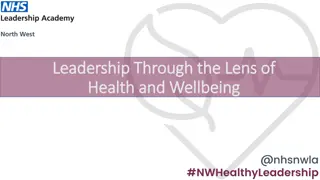Understanding the Importance of Implementing a Wellbeing Framework in Education
Exploring the rationale behind introducing a new wellbeing framework in educational settings, this content delves into the significance of promoting positive mental health and its impact on learning outcomes. It discusses the connection between wellbeing, student satisfaction, engagement, and social-emotional behavior, emphasizing the need for tools and processes that support mental health and overall wellbeing. By focusing on fostering good wellbeing and preventing mental ill-health, the framework aims to create a conducive environment for learning and holistic development.
Download Presentation

Please find below an Image/Link to download the presentation.
The content on the website is provided AS IS for your information and personal use only. It may not be sold, licensed, or shared on other websites without obtaining consent from the author. Download presentation by click this link. If you encounter any issues during the download, it is possible that the publisher has removed the file from their server.
E N D
Presentation Transcript
Hearts & Minds PESA Queensland Conference 2018
What will this workshop cover? 1. Why a new wellbeing framework at MBC? 2. Why Hearts & Minds? Where does this framework come from? 3. How will we apply the framework at MBC? 4. How was Hearts & Minds launched? 5. How will we measure the effectiveness of Hearts & Minds?
Why a new wellbeing framework? The concept of well-being comprises two main elements: feeling good and functioning well. Feelings of happiness, contentment, enjoyment, curiosity and engagement are characteristic of someone who has a positive experience of their life. Equally important for well-being is our functioning in the world. Experiencing positive relationships, having some control over one s life and having a sense of purpose are all important attributes of wellbeing. (New Economics Foundation, 2008)
Why a new wellbeing framework? 560 000 Australian children (1:7) have had a mental health condition in the previous 12 months Up to 10% of Australian 14 & 15-year-olds self harm; up to 5% attempt suicide each year (Child & Adolescent Survey, 2015) (Australian Institute of Family Studies, 2017) 40% of parents report schools as the place that identifies a child might need support Half of all adult mental health problems begin before the age of 14 (Kessler et al, 2005) (Child & Adolescent Survey, 2015)
Why a new wellbeing framework? A wellbeing framework provides a platform for wellbeing education Focuses on the tools and processes that promote good mental health Aims to foster good wellbeing and prevent mental ill health
Why a new wellbeing framework? Link between wellbeing and learning Student wellbeing is strongly linked to learning.A student s level of wellbeing at school is indicated by their level of satisfaction at school, their engagement with learning and their social-emotional behaviour. It is enhanced when schools in partnerships adopt evidence-informed practice with families and the community. (Noble, 2008) Wellbeing is the oil of learning . (Mann, 2006) Wellbeing is not the destination but the nourishment for the learning journey. (Mann, 2006)
Why a new wellbeing framework? OECD identifies teachers, schools and parents have a role to play in improving the wellbeing of 21st century children (Choi, 2018) A need to align our approach to pastoral care with an evidence-based framework A framework allows ongoing auditing of programs
Why Hearts & Minds? Pastoral Team has been investigating possible wellbeing frameworks for some years needed to fit MBC s context Explored Positive Education 2 criteria i. Evidence-based ii. Alignment with MBC s values and mission 2016 investigated The 5 Ways to Wellbeing and developed a proposal
Why Hearts & Minds? What is the The 5 Ways to Wellbeing? A wellbeing framework developed by the UK s New Economics Foundation (nef) Involved the development of a set of 5 evidence-based actions that would improve personal wellbeing (i.e. help individuals feel better and function better)
Why Hearts & Minds? What are the 5 actions?
Why Hearts & Minds? Audits were conducted at MBC (in Primary and Secondary) and at MBBC Programs such as HPE, RE, year level camps, service learning, PYP (Primary), PMP (in Secondary), House (Secondary) were evaluated in terms of the 5 actions.
Why Hearts & Minds? 5 Ways to Wellbeing Year 7 PMP Year 7 HPE House Year 7 RE & Service learning Year 7 experience Connect Be Active Take Notice Keep Learning Give
Why Hearts & Minds? 5 Ways to Wellbeing Year 7 PMP Year 7 HPE House experience Year 7 RE & Service learning RE classes are open, inquiry based classes where big philosophical questions are pondered in an open and supportive environment. Year 7 Camp Sense of belonging Recognising emotions Vertical form structure Form and House activities working across all year levels 7- 12 Year 7 and Year 11 IYC in each form big sister relationship Year 7s in randomly mixed groups during the day House groups in the evening friendship groups for sleeping cabins. Connect Dimensions of health Health trends Physical health Swimming Health related fitness components FITT Principles Fitness testing Interhouse Swimming Interhouse Cross Country Interhouse Athletics Treasure Hunts Dance off - Musical Extravaganza dance component for all girls in each year level Rafting Flying Fox Orienteering Hike Giant swing Be Active
Why Hearts & Minds? 5 ways to wellbeing PYP Learner profile PYP Attitudes Give Be Active Take Notice Keep Learning Thinkers, reflective, courageous Connect Communicators, principled, open minded Caring Balanced Knowledgeable, inquirers Appreciation, empathy, tolerance Enthusiasm, curiosity, Confidence, commitment, integrity, independence Creativity Cooperation, respect Kids Matter Service Learning Anti bullying actions Random Actions wall Walk for Others Easter Egg donations Empty Christmas Tree Birthday book or sponsor child donations Acknowledgements at assembly Yr 1-3 swim carnival P-3 athletics Yr 3 camp Andrews Cup events Move to Learn Co-curricular activities You Can Do It Cyber safety education SMACK 3 way and student led conferences Greene-ware You Can Do It Chapel services Social/emotional testing Optional external testing Kids Matter You Can Do It Class buddies Essential agreements Excursions/incursions Assemblies Choirs and ensembles P-3
Why Hearts & Minds? P - 3 4 - 6 7 8 9 10 11 12 + + + + + + ? + + Connect + + + + + + + ? + Be active + + + ? + ? + ? + ? + ? + ? Take notice + + + + + + + + Keep learning + ? + ? + ? + ? + ? + ? + ? + ? Give
Why Hearts & Minds? A random sample of Year 7-11 students (P = 126) completed surveys which asked a series of questions using the language of The Five Ways to Wellbeing
Why Hearts & Minds? Results indicated that the 5 actions were already embedded in our approach to pastoral care and student wellbeing. However, it also showed there were areas that needed further development.
How will we apply the framework? No change to our approach, but we will continue to evaluate our pastoral work and our wellbeing programs 5 Ways to Wellbeing will overlay current approach and be called Hearts & Minds Hearts & Minds comes from our tagline: Breadth of mind. Depth of heart. The 5 actions will be explored in pastoral programs (e.g. PYP, PMP, House, Service Learning)
How was Hearts & Minds launched? Presentation to staff at staff meeting To students from students (the College Captains) at an Assembly presentation Letter to parents Presentation to parents at Parent Forum Newsletter article, bookmarks and poster
What about staff wellbeing? Staff wellbeing audit Feedback from staff about ideas to foster staff wellbeing Staff Wellbeing Committee was started
How will we measure the effectiveness of Hearts & Minds? Student wellbeing - ACER SEW Survey Exploring a partnership with University of Adelaide and other methods of measuring student wellbeing and teacher wellbeing
How does Hearts & Minds align with policy and procedures? Hearts and Minds Five Ways to Wellbeing Positive Behaviours Policy and Procedure (MBC) Network User Agreement Mobile Phone Procedures College Behaviour Expectations Mental Health Strategy Anti Bullying Strategy
Hearts & Minds When educating the minds of our youth, we must not forget to educate their hearts - Dalai Lama























